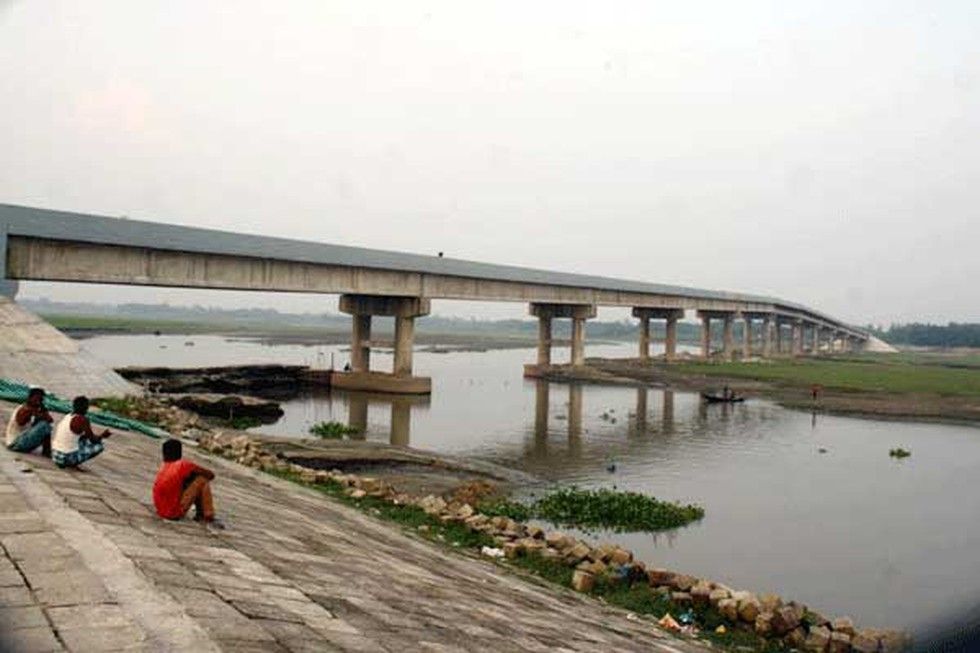Saif
Senior Member
- Joined
- Jan 24, 2024
- Messages
- 16,254
- Likes
- 8,083
- Nation

- Axis Group

Rethinking Feni’s geopolitical significance
KM Saiful Bashar 29 August, 2024, 00:00
AS A conscious citizen of Bangladesh, I have often reflected on our nation’s vulnerabilities — both natural and geopolitical. Recent events have once again brought these concerns to the forefront of public discourse. The devastating floods in Feni and surrounding areas, which left these districts submerged and disrupted the entire economic cycle, serve as a stark reminder of the strategic and economic importance of certain geographical locations within our country.
The Feni waistline, running through the Feni district, represents a critical vulnerability for Bangladesh. This line serves as a critical connection between the eastern and western parts of Bangladesh. The recent floods that submerged Feni highlighted the fragility of this corridor and its impact on the national economy. When Feni’s infrastructure was overwhelmed, it caused a domino effect, paralysing trade and transport and underscoring the urgent need for strategic planning and investment in these regions.
Feni is uniquely positioned as a linchpin in Bangladesh’s geographical landscape. It shares borders with Cumilla to the north and Chattogram to the south, both of which are integral parts of the nation’s transportation and economic networks. The district’s location makes it an unavoidable transit point for road and rail routes connecting Dhaka with Chattogram, the largest port city and economic hub of Bangladesh. Unlike Cumilla, which can be bypassed to a limited extent, Feni’s geographical placement makes it an indispensable link, ensuring the continuous flow of goods and people between these vital regions.
Three significant rivers — the Muhuri, Feni, and Selonia — flow through Feni, further enhancing the district’s strategic value. These rivers not only support local agriculture but also play a crucial role in cross-border relations with India, given their shared usage and management. Feni’s proximity to the Indian state of Tripura adds another layer of strategic importance, as it serves as a gateway for cross-border trade and cultural exchange. The district is thus a focal point for maintaining robust border security and fostering diplomatic relations with India.
From a geopolitical standpoint, the Feni waist line is critical. Bangladesh’s location, bordered by India on three sides and the Bay of Bengal to the south, necessitates careful consideration of these vulnerabilities. The Feni waist line holds significant geoeconomic importance. The district of Feni is a hub that connects the capital, Dhaka, with the port city of Chittagong, and it serves as a vital link in the country’s supply chain. The recent flooding exposed how quickly and easily this link can be severed, causing widespread economic disruption.
Given these vulnerabilities, it is imperative for the government to take immediate and strategic action. First and foremost, the depth and capacity of the rivers flowing through Feni must be increased. The recent floods demonstrated that these rivers are currently incapable of handling sudden surges in water levels. This requires a comprehensive river management plan, including dredging to increase depth and the construction of embankments to control overflow. Such measures would not only mitigate the impact of future floods but also enhance the navigability of these rivers, boosting local commerce and connectivity.
Secondly, the government’s current initiative to build a road connecting the Chittagong port with the Mirershorai Economic Zone is commendable. However, this project should be expanded further. The road should be extended beyond Mirershorai up to Sonagazi, and, importantly, there should be a direct connection to Sonaimuri in Noakhali. This would create an alternative route in case of emergencies like the recent flood, allowing for the bypassing of Feni’s existing road network when necessary. This expanded road network would not only provide a more robust infrastructure in times of crisis but also foster greater economic integration between different regions of the country.
Additionally, there should be a focus on developing a multimodal transportation network that integrates roads, rail, and waterways. By doing so, we can ensure that even if one mode of transportation is compromised, others can still function, thus maintaining economic stability. For instance, the development of a rail link parallel to the proposed road could provide an additional layer of redundancy, reducing our reliance on any single mode of transport.
Moreover, the government should consider the construction of more flood shelters and the implementation of community-based disaster management programmes in vulnerable areas like Feni. These measures would not only save lives during natural disasters but also minimise the economic disruption caused by such events. By training local communities in disaster preparedness and response, we can create a more resilient population that is better equipped to handle crises.
To further enhance the strategic resilience of the Feni waistline, the government should also invest in advanced surveillance and monitoring systems. This would enable real-time assessment of any emerging threats, whether natural or man-made, allowing for swift and coordinated responses. Such systems could include satellite monitoring, drone surveillance, and the establishment of local observation posts.
Finally, there must be a national discussion on these issues, involving all stakeholders, including local communities, civil society organisations, and international partners. This discussion should aim to raise awareness about the importance of these regions and build consensus on the need for immediate action. Only through collective effort can we ensure that Bangladesh is prepared to face the challenges posed by its geographical vulnerabilities.
KM Saiful Bashar is a retired army personnel.
KM Saiful Bashar 29 August, 2024, 00:00
AS A conscious citizen of Bangladesh, I have often reflected on our nation’s vulnerabilities — both natural and geopolitical. Recent events have once again brought these concerns to the forefront of public discourse. The devastating floods in Feni and surrounding areas, which left these districts submerged and disrupted the entire economic cycle, serve as a stark reminder of the strategic and economic importance of certain geographical locations within our country.
The Feni waistline, running through the Feni district, represents a critical vulnerability for Bangladesh. This line serves as a critical connection between the eastern and western parts of Bangladesh. The recent floods that submerged Feni highlighted the fragility of this corridor and its impact on the national economy. When Feni’s infrastructure was overwhelmed, it caused a domino effect, paralysing trade and transport and underscoring the urgent need for strategic planning and investment in these regions.
Feni is uniquely positioned as a linchpin in Bangladesh’s geographical landscape. It shares borders with Cumilla to the north and Chattogram to the south, both of which are integral parts of the nation’s transportation and economic networks. The district’s location makes it an unavoidable transit point for road and rail routes connecting Dhaka with Chattogram, the largest port city and economic hub of Bangladesh. Unlike Cumilla, which can be bypassed to a limited extent, Feni’s geographical placement makes it an indispensable link, ensuring the continuous flow of goods and people between these vital regions.
Three significant rivers — the Muhuri, Feni, and Selonia — flow through Feni, further enhancing the district’s strategic value. These rivers not only support local agriculture but also play a crucial role in cross-border relations with India, given their shared usage and management. Feni’s proximity to the Indian state of Tripura adds another layer of strategic importance, as it serves as a gateway for cross-border trade and cultural exchange. The district is thus a focal point for maintaining robust border security and fostering diplomatic relations with India.
From a geopolitical standpoint, the Feni waist line is critical. Bangladesh’s location, bordered by India on three sides and the Bay of Bengal to the south, necessitates careful consideration of these vulnerabilities. The Feni waist line holds significant geoeconomic importance. The district of Feni is a hub that connects the capital, Dhaka, with the port city of Chittagong, and it serves as a vital link in the country’s supply chain. The recent flooding exposed how quickly and easily this link can be severed, causing widespread economic disruption.
Given these vulnerabilities, it is imperative for the government to take immediate and strategic action. First and foremost, the depth and capacity of the rivers flowing through Feni must be increased. The recent floods demonstrated that these rivers are currently incapable of handling sudden surges in water levels. This requires a comprehensive river management plan, including dredging to increase depth and the construction of embankments to control overflow. Such measures would not only mitigate the impact of future floods but also enhance the navigability of these rivers, boosting local commerce and connectivity.
Secondly, the government’s current initiative to build a road connecting the Chittagong port with the Mirershorai Economic Zone is commendable. However, this project should be expanded further. The road should be extended beyond Mirershorai up to Sonagazi, and, importantly, there should be a direct connection to Sonaimuri in Noakhali. This would create an alternative route in case of emergencies like the recent flood, allowing for the bypassing of Feni’s existing road network when necessary. This expanded road network would not only provide a more robust infrastructure in times of crisis but also foster greater economic integration between different regions of the country.
Additionally, there should be a focus on developing a multimodal transportation network that integrates roads, rail, and waterways. By doing so, we can ensure that even if one mode of transportation is compromised, others can still function, thus maintaining economic stability. For instance, the development of a rail link parallel to the proposed road could provide an additional layer of redundancy, reducing our reliance on any single mode of transport.
Moreover, the government should consider the construction of more flood shelters and the implementation of community-based disaster management programmes in vulnerable areas like Feni. These measures would not only save lives during natural disasters but also minimise the economic disruption caused by such events. By training local communities in disaster preparedness and response, we can create a more resilient population that is better equipped to handle crises.
To further enhance the strategic resilience of the Feni waistline, the government should also invest in advanced surveillance and monitoring systems. This would enable real-time assessment of any emerging threats, whether natural or man-made, allowing for swift and coordinated responses. Such systems could include satellite monitoring, drone surveillance, and the establishment of local observation posts.
Finally, there must be a national discussion on these issues, involving all stakeholders, including local communities, civil society organisations, and international partners. This discussion should aim to raise awareness about the importance of these regions and build consensus on the need for immediate action. Only through collective effort can we ensure that Bangladesh is prepared to face the challenges posed by its geographical vulnerabilities.
KM Saiful Bashar is a retired army personnel.



































